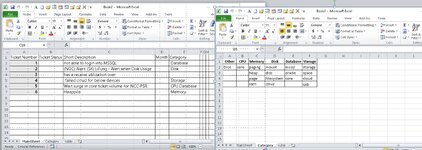Excel Learner007
New Member
- Joined
- Feb 26, 2011
- Messages
- 18
Hi Everyone,
We have a huge sheet (almost 40k Rows). Now, there is a column "Short Description" and based on the keywords in that column, we need to categorize it as either CPU, Memory, Disk, Database or Storage. Below is the categorization. Would be great if someone can help.
We have a huge sheet (almost 40k Rows). Now, there is a column "Short Description" and based on the keywords in that column, we need to categorize it as either CPU, Memory, Disk, Database or Storage. Below is the categorization. Would be great if someone can help.
| Other | CPU | Memory | Disk | Database | Storage |
| aix | core | paging | mount | mssql | Storage |
| bios | wait | heap | data | oracle | Space |
| cluster | Cache | page | filesystem | sql | |
| esx | delay | ram | drive | sybase | |
| rate | handler | swap | nfs | sybdump | |
| linux | performance | temp | read | ||
| nodes | processor | threshold | storage | ||
| slow | queue | timeout | write | ||
| unix | stats | vol | |||
| windows | |||||
| vmware | |||||
| vsphere | |||||
| vmtools |






